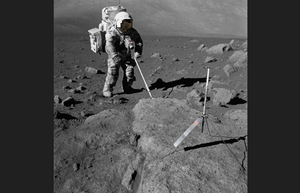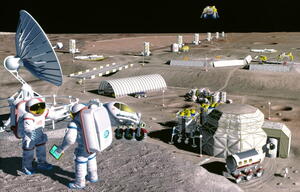Helium 3: Let's go mine the moon!
When astronaut Harrison Schmitt stepped onto the Moon, on 12 December 1972, oil was trading at $3.60 a barrel—$18.30 inflation-adjusted—and oversized cars happily guzzled gallon after gallon of premium and unleaded. The "energy crisis" was something the world hadn't heard about yet.
Thirty-seven years later, no one is walking on the Moon, world energy consumption has almost doubled, oil reserves are fast disappearing and mankind is facing one of the harshest challenges in its history.
A geologist by training, former-astronaut Schmitt believes he has a solution. He is convinced that fusion could help "meet an anticipated eightfold or higher increase in energy demand by 2050."
In his recently published book, "Return to the Moon" (¹), he presents a compelling case for exploiting our satellite's Helium-3 (³He) resources—a possible fuel for "2nd generation" fusion power plants.
³He is a non-radioactive isotope of "normal" helium (4He). It can fuse with deuterium (³He+D) and with itself.
The ³He+D reaction occurs at temperatures in the one billion-degree range and, contrary to deuterium + tritium fusion, only releases charged particles. In principle this means that no neutron flux will activate and alter the chamber walls. In reality, the ³He+D reaction does release some neutrons, since part of the deuterium in the plasma will inevitably fuse with itself. But this can be mitigated.
The ³He+³He reaction, which occurs at even higher temperatures, presents better prospects; its energy yield (12.9 MeV) is still high and it releases no neutrons.
Both reactions unfortunately come with a slight technicality : the Moon crust is the closest place to get ³He in significant quantities.
This is not enough to deter a man who has accumulated the experience of a geologist, a moonwalking astronaut, a one-term US Senator and a successful businessman. Mining ³He from the Moon, Schmitt passionately argues, is not only necessary and feasible—it could be quite profitable.
Both a prophet and an accountant, Schmitt computed the figures of a privately-financed mining venture on the Moon. If launching costs could be brought down to $3,000 per kilo—compared to $59,400 per kilo in the 1970s—and development of a ³He fusion power plant and a new booster system could be kept under $10 billion, then according to his detailed business plan, it's got to be done.
(¹) "Return to the Moon : Exploration, enterprise, and energy in the human settlement of space," by Harrison Schmitt, foreword by Neil Armstrong. Copernicus Books, in association with Praxis Publishing, Ltd. $25.
Moon Fuel or Moonshine?
Provided that mining the moon is feasible, which many specialists doubt, the ³He+³He fusion reaction certainly has great potential. At the laboratory level, research at the University of Wisconsin (US) has proved it could be achieved.
Physicists who gave some thought to the "2nd generation" of fusion fuels prefer betting on the perfectly aneutronic "proton+Boron 11" (p+¹¹B) reaction(1). "This would be by far the ideal reaction," says Carlos Alejaldre, ITER Deputy Director-General for Safety & Security. But the challenges are quite formidable: the reaction rate for p+¹¹B peaks at around 6.5 billion degrees and confinement concepts would have to be developed that differ radically from those of tokamaks.
(¹) A proton is a hydrogen ion (H+)



